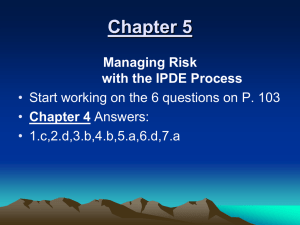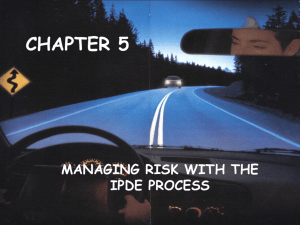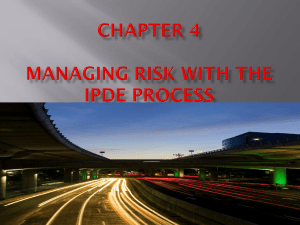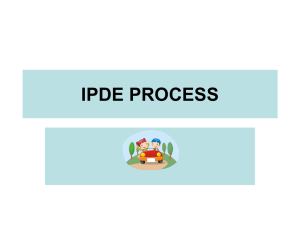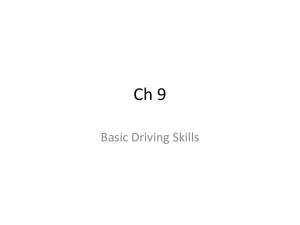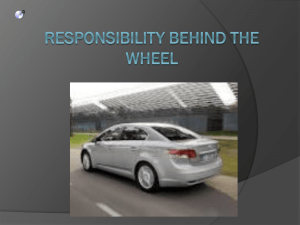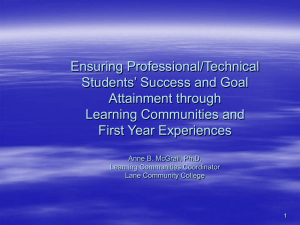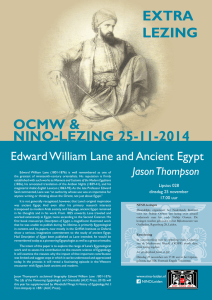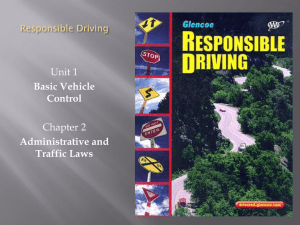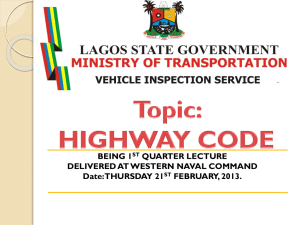IPDE Process
advertisement
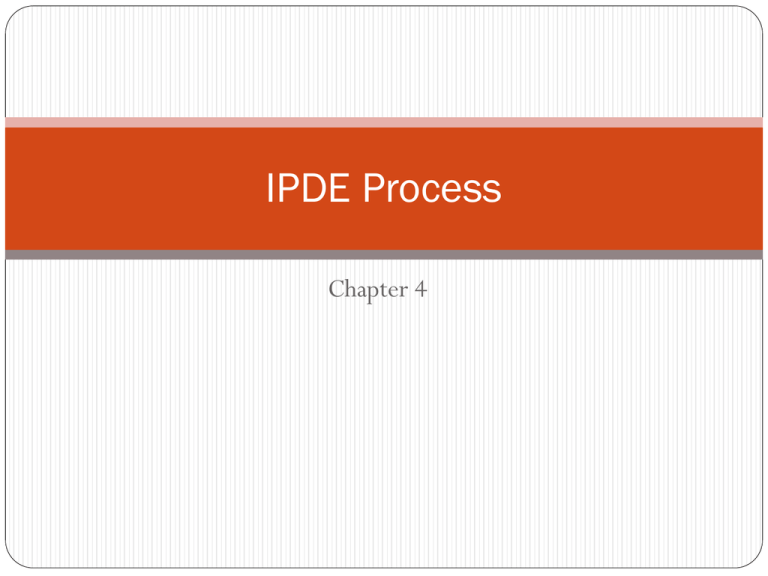
IPDE Process Chapter 4 IPDE Process Need for organized system to drive Reduces close calls and collisions Manage risk Driving Risks – 3 Components #1. Risk Factors due to Driver, even other drivers Adjusting radio Emotion – anger/your boyfriend/girlfriend just broke up with you Primping – combing hair, putting on mascara, shaving Drinking alcohol Cell phone use #2. Risk Factors due to Automobile Bald Tires Poorly adjusted brakes Ineffective Windshield Wipers Broken Headlight Dirty Windshield IPDE Process Driving Risks –continued #3. Roadway Risks Bright sun Construction Snow / Ice Sharp Curves Good drivers make every effort to manage & lower risks IPDE Process – organized system of see, thinking, making judgements and responding Identify – use visual search pattern to look for Clues Other users of the HTS (Highway Traffic System) assume they will make mistakes example: speeders Road Conditions – hills, curves, lane changes, bicyclists, pedestrians, intersections Traffic Concerns IPDE Process IPDE Process – organized system of see, thinking and responding Identify – use visual search pattern Smith System - 5 Rules that help drivers develop good seeing habits Aim High In Steering – look 12-15 seconds ahead of your vehicle Keep Eyes Moving Get the Big Picture Make Sure Others See You Leave Yourself an Out Zone Control System – organized method of managing the 6 zones around your car - see a zone change – check other zones – create space for yourself by adjusting speed & lane position – Communicate Open Zone – no restriction Line of Sight – intended path of travel Target Area – center of intended path Closed Zone – zone not open - restricted “line of sight” o Examples: stop light (front zone), parked car (right front zone) IPDE Process Zones – pg 65 & 66 Left Front Zone Left Rear Zone Front Zone Rear Zone Right Front Zone Right Rear Zone IPDE Process 3 Searching Ranges Target Area Range Distance ahead of vehicle Use to evaluate path of travel 12-15 Second Range Space will travel in next 12-15 seconds 4-6 Second Range Space will travel in next 4-6 seconds Target Area Range 12-15 Second Range 4-6 Second Range IPDE Process Checking Your Zones Orderly Visual Search Pattern Sample: Driving Straight: Target Area Left Front – Front – Right Front in 12-15 sec range Rear Zone - Rearview mirror 4-6 second range 12-15 second range 4-6 range Rearview mirror Speedometer & Gauges o Don’t stare o Practice as a passenger IPDE Process Field of Vision – area see around you Most of us can see 90 degrees to each side = 180 degrees Central Vision – right in front of you 10 degrees – see clearly Peripheral Vision – area see to right or left – Outer edges see less clearly CentralVision Peripheral Vision Peripheral Vision FIELD OF VISION IPDE Process Review Identify Component: Aim High Steering – look ahead (12-15 sec) Keep Eyes Moving – develop scanning technique Get The Big Picture Develop Selective Seeing Choose only events that impact your driving! Open zones that may close Examples: Parked car with wheels turned or exhaust from tail pipe Look for other Users- anticipate them doing the wrong thing! Examples: Speeders Look for Roadway Conditions – Intersections, Hills, Lane changes, road surfaces, bicyclists, pedestrians IPDE Process Predict – once you identify - predict how it may effect you What is happening, what could happen, how could this effect you?? Example: Pg 72 – bicyclist & on coming car to left What do you do? Knowledge & Experience will help you identify & predict quicker & faster Most predictions related to changes in zones and looking for an out Don’t Assume other drivers will make good decisions Predict ✔Path of other drivers ✔Action of others ✔Space –Will I have an open zone ✔Pont of Conflict – No open space, where may the conflict occur –Where paths may cross • Examples: pg 73 IPDE Process The more complex situation, the more difficult to identify & predict Speed – Most important factor in control of your vehicle Changes with traffic & weather conditions Increased Speed decreases time available for IPDE process Traction – basic requirement for vehicle control Gripping power between tires and road surface IPDE Process Decide Once you’ve identified a situation… Predicted a possible conflict … Decide upon the action Followed by Execute step Examples: Maintain speed Change speed may not always mean slowing down IPDE Process Decide Examples: Change direction – keep a space cushion - continued May change lane positions to keep cushion pg 76 o o o o Center of Lane Right Side of Lane Left Side of Lane May need to make greater change Try to detect a changing zone condition 12 sec in advance IPDE Process Decide Examples: continued Communicate with others Lights – headlights, taillights, brake lights, turn signal, etc Horn Car Position Eye Contact Body Movement Combination Strategies to keep space around your vehicle Minimize Hazard –put distance between self and hazard Example: Passing parked cars IPDE Process Strategies to keep space around your vehicle Separate Hazards–more than one hazard at a time Don’t handle them all at one time You do this by adjusting your speed Example: On coming car and parked cars on right Compromise Space – Sometimes hazards can’t be minimized and can’t be separated Give as much space as possible to greater hazard Example: On coming car moves into your lane with cars parked on right IPDE Process Execute carry out decision to avoid conflict Control Speed Accelerating Decelerating / Braking Check Rear Zone Avoid Locking Brakes – loose steering control o Most cars have antilock breaks – break hard – don’t pump breaks Steer Don’t over steer – could loose control Don’t make jerky sudden movements Communicate Make it early so other know your intentions Combined Actions IPDE Process Putting It Into Action Practice – as you ride with others Commentary Driving – talk out loud Takes Time The more complex traffic situation the longer it takes
